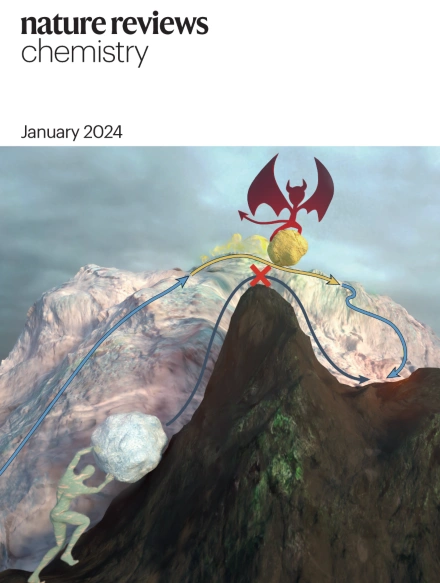自组装无机手性超结构
IF 38.1
1区 化学
Q1 CHEMISTRY, MULTIDISCIPLINARY
引用次数: 58
摘要
将不同成分、尺寸和形状的无机纳米粒子受控组装成具有集体功能的高阶结构,是化学、物理学、材料科学和纳米技术领域追求的核心目标。新出现的手性超结构在纳米尺度上打破了空间对称性,由于其独特的自旋特性以及在光学、催化、生物等领域的潜在应用,引起了人们的特别关注。目前已开发出多种自下而上的策略,根据构建模块的内在构型偏好、外部场或手性模板来构建无机手性超结构。自组装的无机手性超结构与有机同类结构相比,由于构件之间的强电/磁耦合而显示出显著的优越光学活性。在这篇综述中,我们将讨论制备自组装无机手性超结构的最新进展,重点关注组装过程中对称性破缺的驱动力。重点介绍了手性特性和应用,并讨论了研究工作重点的前瞻性轨迹。无机纳米粒子的手性排列带来了新的特性和功能,这些特性和功能与单个构件相比截然不同。本综述讨论了自组装无机手性超结构的制备、特性和新兴应用方面的最新进展。本文章由计算机程序翻译,如有差异,请以英文原文为准。

Self-assembled inorganic chiral superstructures
Controlled assembly of inorganic nanoparticles with different compositions, sizes and shapes into higher-order structures of collective functionalities is a central pursued objective in chemistry, physics, materials science and nanotechnology. The emerging chiral superstructures, which break spatial symmetries at the nanoscale, have attracted particular attention, owing to their unique chiroptical properties and potential applications in optics, catalysis, biology and so on. Various bottom-up strategies have been developed to build inorganic chiral superstructures based on the intrinsic configurational preference of the building blocks, external fields or chiral templates. Self-assembled inorganic chiral superstructures have demonstrated significant superior optical activity from the strong electric/magnetic coupling between the building blocks, as compared with the organic counterparts. In this Review, we discuss recent progress in preparing self-assembled inorganic chiral superstructures, with an emphasis on the driving forces that enable symmetry breaking during the assembly process. The chiroptical properties and applications are highlighted and a forward-looking trajectory of where research efforts should be focused is discussed. The chiral arrangement of inorganic nanoparticles brings new properties and functionalities that are distinct compared with the individual building blocks. This Review discusses the recent progress in the preparation, properties and emerging applications of self-assembled inorganic chiral superstructures.
求助全文
通过发布文献求助,成功后即可免费获取论文全文。
去求助
来源期刊

Nature reviews. Chemistry
Chemical Engineering-General Chemical Engineering
CiteScore
52.80
自引率
0.80%
发文量
88
期刊介绍:
Nature Reviews Chemistry is an online-only journal that publishes Reviews, Perspectives, and Comments on various disciplines within chemistry. The Reviews aim to offer balanced and objective analyses of selected topics, providing clear descriptions of relevant scientific literature. The content is designed to be accessible to recent graduates in any chemistry-related discipline while also offering insights for principal investigators and industry-based research scientists. Additionally, Reviews should provide the authors' perspectives on future directions and opinions regarding the major challenges faced by researchers in the field.
 求助内容:
求助内容: 应助结果提醒方式:
应助结果提醒方式:


